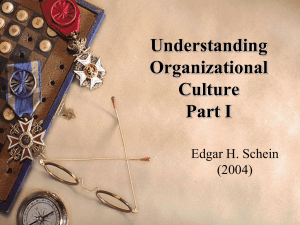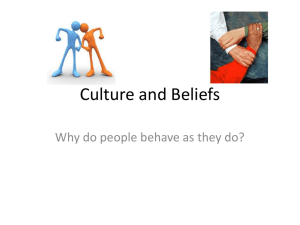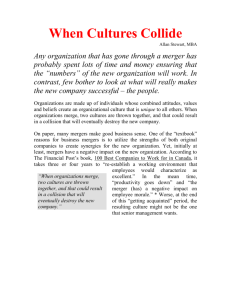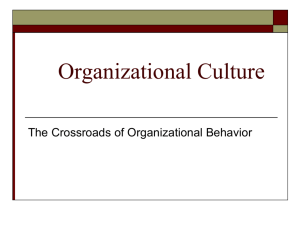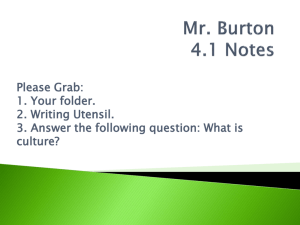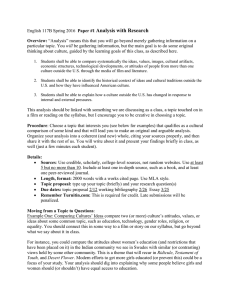Ch 3: Organizational structure and change
advertisement
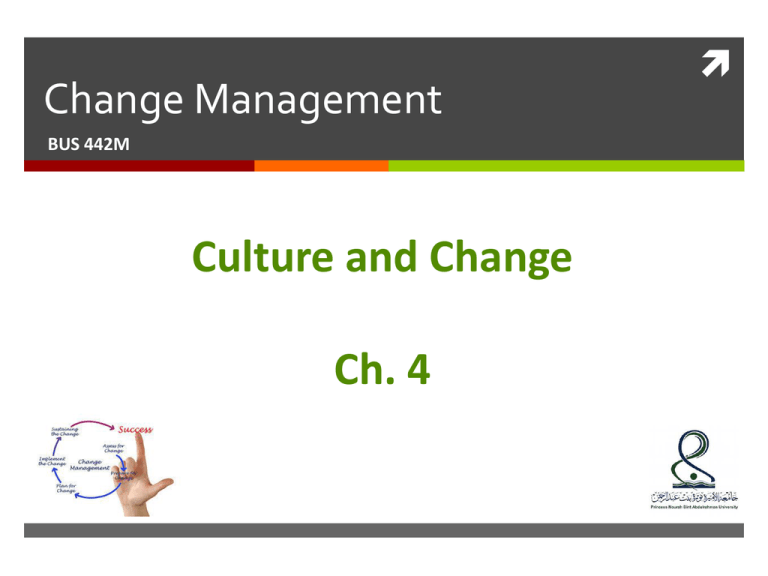
Change Management BUS 442M Culture and Change Ch. 4 Learning objectives Recognize of the importance of the informal organization and its role in the relation to organizations and change; Explain the meaning of culture; Compare and contrast different cultural models and typologies; Examine how cultural differences impact upon organizational change. The informal organization The culture and politics of many organizations constrain the degree of change and transformation in which they can successfully engage, and meeting the challenges and demands of the wider environment. Therefore, regardless of how well change might be planned in terms of the more formal organizational characteristics, it is the hidden informal aspects of organizational life which will act to help or hinder it. What Is an Organizational Culture? Organizational culture Definition 1 system of shared beliefs and values that develops within an organization and guides the behavior of its members Also called corporate culture This is the social glue that binds Members of the organization Together. What Is an Organizational Culture? People are seen as being from different cultures if their ways of life as a groups differ significantly, one from another. Culture has a cognitive ( to do with thinking), affective (to do with feeling) and behavioral characteristics. Culture can be changed, in fact it is changing all the time. The issue is the degree of change to which culture can be submitted over the short and long term and the process for doing this. Much depends on the perspective adopted and the type of change proposed. What Is an Organizational Culture? 3 perspectives can be identified Culture can be managed Culture may be manipulated Culture cannot be consciously changed There is a general agreement that there is need to: Assess the current situation Have some idea on what the aimed for situation looks like Work out the ‘what’ and ‘how’ of moving the organization, or part of it, away from its current culture to what is perceived to be a more desirable one The ingredients of culture Brown 1995 lists the following characteristics of culture: Observable artifacts physical manifestations such as manner of dress, awards, myths and stories about the company visible behavior exhibited by managers and employees The ingredients of culture Language in the form of jokes, stories, myths and legends.. Behavior patterns in the form of rites, rituals, ceremonies. Norms of behavior Heroes ( past and present employees who do great things) Symbols and symbolic action Beliefs, values and attitudes Ethical codes The ingredients of culture • Basic assumption about what is important represent the core values of the organization ’ s culture ; which are not observable, represent the core beliefs that employees have about their organization those taken for granted and highly resistant to change • history Describing organizational culture People orientation: the degree to which management decisions take into consideration the effect of outcomes on people within the organization. Team orientation: the degree to which work activities are organized around groups rather than individuals. Aggression: the degree to which people are aggressive and competitive rather than easygoing. Stability: the degree to which organizational activities emphasize maintaining the status quo in contrast to growth Describing organizational culture Levels (Schein) 1/ Artifacts: the annual report of the company includes policies concerned with employees as well as customers and shareholders. 2/Espoused values: pay and conditions for workers should be fair and their views taken into account on matters that affect them. However, gaining contracts and satisfying customers is a priority. 3/ Basic underlying assumptions: all people should be treated with dignity whatever their level and function Describing organizational culture Values level (Hofstede) 1/ Values 2/ Rituals: activities and ceremonies, planned an unplanned, that celebrate important occasions and accomplishments in the organization’s life 3/ Hero: person whose accomplishments embody the values of the organization 4/Symbols: an object, act, quality, or event that conveys meaning to others Describing organizational culture Levels of Culture (Combination of Schein’s and Dyer’s models) 1. Artifacts 2.perspective: it is acceptable for trade union representatives to know what volume of work is expected in the future, but the directors are not expected to talk about details of the proposed expansion until it becomes well-established. 3. Values 4. Basic/tactic assumptions Objectivist and interpretive views of culture How to bring meaning to the concept of culture itself. There is a distinction between 2 classifications of culture: The objectivist or functional view of culture Implies that organizations have cultures and further implies that changing cultures is not that difficult if certain procedures are followed Objectivist and interpretive views of culture There is a second view of culture, which - interprets the meaning of culture as a metaphor for the concept of organization itself. - Culture is something an organization is (In essence this means that organizations are socially constructed realities and that, rather than being defined by their structures, rules and regulations, they are constructed as much in the heads and minds of their members and are strongly related to members’ - self-concept and identity. The cultural web Is a model of organizational culture which brings together the idea of culture as congruent with everything that happens in an organization ( Johnson et al 2008). The cultural web is all-encompassing in the organizational elements which it includes. They lie within a cultural web which bonds them to the day-to-day action of organizational life. The cultural web The different elements of the cultural web: Rituals and routines Stories Symbols Power structure Organizational structures Control systems The paradigm The cultural web The notion of culture as a metaphor for organization also encompasses the concept of sub-cultures. Alvesson recommends combining perspectives at 3 levels: The organization as culture (unitary and unique) The organization as a meeting place for great cultures Local perspectives on organisationnel subcultures. A cultural compass Hall’s compass model of culture and its associated culture typologies have been developed through an apparent interest in cultural differences in partnerships. There are 2 components of behavior or cultural styles of behavior: Assertiveness: The degree to which a company’s behaviors are seen by others as being forceful or directive. Responsiveness: The degree to which a company’s behaviors are seen by others as being emotionally expressed. Dimensions of organizational culture The structural view of culture Handy (1993) refers to organizational culture at atmosphere ways of doing things, levels of energy and levels of individual freedom – or collectively, the sets of values and norms and beliefs – reflected in different structures and systems. He suggested four organizational culture types: Handy's structural view of culture 1/Power culture In which a single person or group tends to dominate. Decision making is centralized. Family businesses, 2/ Role culture Work by logic and rationality. Activity is controlled more by rules and regulations than by personal directive from the top. 3/ Task culture Represented by Project work associated with matrix-type structures. Is not particularly concerned with personal power or hierarchy, but with marshaling the required resources to complete work and work efficiently and effectively. 4/Person culture An unusual culture. It exists only to service the needs of the participating members. Organizational culture and the external environment Deal and Kennedy’s (1982) proposed four generic cultures: The tough-guy, macho culture: - People in these organizations regularly take High risks and rapid feedback on the outcomes of their actions: example: police departments - Focus on speed rather than endurance - Failure is punished Organizational culture and the external environment The work-hard/ play-hard culture - Low risk but quick feedback on actions such as sales organizations that incorporate hard work and fun. - Risks are small because an individual sale is unlikely severely damage the salesperson. - Heroes in these organizations are the super salespeople who turn in volume sales - Emphasizes the team because it is the team which makes the difference. to Organizational culture and the external environment Bet-your-company culture - The risks are high and the feedback on actions and decisions takes a long time. Bet-your- company organizations are those that invest heavily in projects which take years to come to result: e.g. Oil companies - People bet the company rather than themselves - All decisions are carefully weighed and based on careful research - influenced by short-term economic fluctuations in the economy Organizational culture and the external environment The process culture - There is low risk and slow feedback on actions and decisions: e.g. public and government organizations. - Working with little feedback, employees have no sense of their own effectiveness or otherwise. - They tend to concentrate on the means which things are done rather than what should be done - Effective when dealing with a stable and predictable environment, but find it difficult to react quickly to changing circumstances. Organizational culture, structure, strategy and the external environment The external-inducted dimensions The internal-inducted dimensions identifies three culture types: production, bureaucratic and professional that derive from organizational structure characteristics. The evolution-inducted dimensions From these, five culture types are identified Organizational culture, structure, strategy and the external environment 3-1/ Stable, with the time orientation towards the past and an aversion to risk. 3-2/ Reactive, with the time orientation towards the present and an acceptance of the minimum risk. 3-3/ Anticipating, also oriented towards the present but more accepting of familiar risks. 3-4/ Exploring, with a time orientation towards the present and the future and an acceptance of increasing risk. 3-5/ Creative, looking forward to the future and accepting risk as normal. The sources of organizational culture After studding how culture is expressed and noting the influences of dominant personalities, professional norms and market economics, among others, on shaping organizational culture. Organizational history and national culture differences also play a part: .1The influence of organizational history The subculture of an organization reflects national culture, professional subculture, and the organization's own history. Regarding the last of these, Robbins emphasizes how the philosophy of organization’s founder and, as time passes, the top management define acceptable behavior. The sources of organizational culture .2The influence of national culture: The literature on cultural similarities and differences between nations identifies a long-standing debate known as the convergence-divergence debate. Those who support the convergence view argue that the forces of industrialization and the use of similar technologies as well as increasing size will push organizations, whatever their location, towards particular configurations with respect to strategy, structure and management. The influence of national culture The markets valuing a global approach to business- an approach in which a company’s units, divisions, teams, functions, and regions are all tightly integrated and synchronized across borders. Opposing this view is the notion that differences in language, religion, social organization, laws, politics, education systems, and values and attitudes will mean that national cultures will not converge but continue to remain distinct. The diversity of national cultures Six different cultural orientations of societies People’s qualities as individuals in terms of whether people are seen as basically good or basicallyBad People’s relationship to their world People’s personal relationships in terms of individualism or collectivism An orientation to either doing or being People’s orientation to time People’s use of space Organization's capacity to change Attitudes to criticism Attitudes to sharing information Attitudes to experimentation in processes and products Degree of willingness to give people autonomy and support them in their actions Degree to which the organization's structure facilitates change Degree of willingness to discuss sensitive issue openly Attitudes to conflict Degree of management’s openness to new ideas – especially from below Organization's capacity to change According to Stalker’s(1961):Culture and structure seem almost to be interchangeable. - Structure and culture as organic types of organization are much more likely to be able to respond to the need for change than mechanistic forms( they are less open to change). Mechanistic vs. Organic Organizations Organization's capacity to change Mechanistic forms are :unlikely to support, without serious trauma, the frame-breaking, transformational or revolutionary types of change. This is likely to be the case because of their structural characteristics, but might also be because of the attitudes, beliefs and values held by the people who work in them. Organizational learning and types of change Single-loop learning (individual learning) An objective or goal is defined and an individual works out the most favored way of reaching the goal. The goal itself is not questioned. Double-loop learning (organizational relearning) Questions are asked not only about the means by which goals can be achieved, but about the ends, the goals it selves. Changing organizational culture to bring about organizational change Culture is, by definition, a dominant influence on organizational life. It follows then that in order to bring about significant organizational change, organizational culture must be managed accordingly. But can culture be managed? The relevance of culture change to organizational change Assessing cultural risk helps management pinpoint where they are likely to meet resistance to change because of incompatibility between strategy and culture. This further allows them to make choices regarding: 1. Ignoring the culture 2. Managing around the culture 3. Changing the culture 4. Changing the strategy to match the culture


